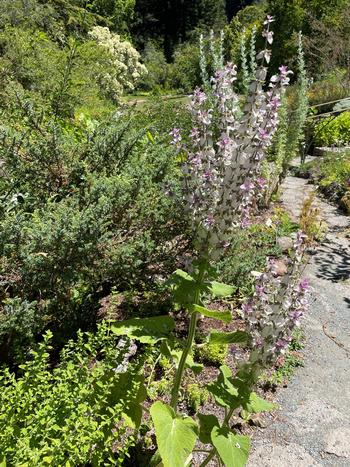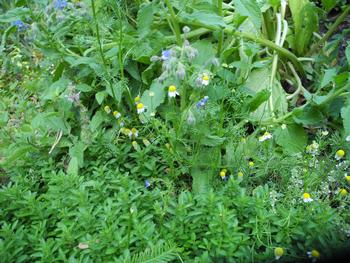Drought-adapted herbs perfect for your Marin garden
-
Anne-Marie Walker
-
Ask gardeners how they select plants “most likely to succeed,” and a frequent response is “observation.” On a visit to Georgia O’Keeffe’s garden at Abiquiu, 50 miles outside Santa Fe, New Mexico, I observed that for centuries, water has been turned on once a week and allowed to flow through a ditch system called acequia, distributing spring water to villagers in an arid landscape. O’Keeffe grew parsley, sage, rosemary, and thyme to make herb salt and dishes like herb rice, herb salad dressing, and herb-stuffed eggs, which she made with yogurt, mustard, and herbs. She also grew sorrel, Mexican tarragon, dill, chives, lovage, mint, and winter savory. O’Keeffe would have agreed with Alan Chadwick, UC Santa Cruz; “The cooking has been done for you in the garden; it is merely finished in the kitchen.”
 Clary Sage, a low-water herb, steals the show in The Herb Garden at UC Berkeley Botanical Garden. Photo: Anne-Marie Walker
Clary Sage, a low-water herb, steals the show in The Herb Garden at UC Berkeley Botanical Garden. Photo: Anne-Marie WalkerTo Marin gardens, I would also add these drought-adapted herbs: pelargoniums, nasturtiums, Mrs. Burns’ Lemon Basil, chamomile, anise hyssop, lavender, lemon balm, lemongrass, lemon verbena, chervil, calendula, and oregano. These low-water herbs afford biodiverse benefits to gardens. To appreciate the restorative powers of herbs, rub the leaves and inhale deeply to capture scent in your olfactory receptors. Then, take a nibble of an herb leaf and allow the taste and texture to roll around your taste buds. You are rewarded with flavors not just sweet and salty but bitter and sour, pungent and cool, and even umami – the Japanese word meaning a pleasant, savory taste or deliciousness.
Much work has been invested in determining the water needs of various garden plants. In addition to observation, you can now look up online how much water a plant needs in the Water Use Classification of Landscape Species, commonly called WUCOLS. With full reservoirs, concerns about drought may be lessening. However, long-term climate change models favor continuing moderate water usage because droughts of the past will recur. To maintain a healthy garden and help plants develop the ability to deal with drought, water where roots are found: for herbs that is about 6 inches deep.
Many herbs from Mediterranean climates around the world are drought-adapted and can be watered once a week. Do any of the following plant stories intrigue you? German chamomile, scientific name Matricaria recutita, belongs to the Asteraceae (Daisy) family. Besides attracting bees, butterflies, and beneficial insects to your garden, chamomile, with its tiny, aromatic, daisy-like blooms, has a charming, nostalgic beauty. Long used to make calming teas, it makes a great aioli for burgers and beautifully flavors cake batters. Amazingly, chamomile can also be used to make botanical prints on fabric. You will be so happy you added this humble Mediterranean herb to your garden. Chamomile planted with Oregano and Borage. Photo: Anne-Marie Walker
Chamomile planted with Oregano and Borage. Photo: Anne-Marie WalkerMexican tarragon, scientific name Tagetes lucida, is native to Central and South America. It blooms in the summer and fall when other herbs are waning. Its cheery, yellow flowers attract bees and butterflies. The glossy leaves of Mexican tarragon are licorice scented and flavored, much like French tarragon, a bloomless cross dating back to the Middle Ages. It succeeds in Marin, where French tarragon often fails. The Aztecs cultivated this herb mainly for tea. It prefers full sun.
Winter savory, scientific name Satureja montana, is a member of the mint family. Native to the Mediterranean, it tastes a bit like oregano and thyme. Often included in ‘Herbes de Provence’ herb blends, savory is used extensively to flavor liqueurs, vermouths, soups, and confectioneries for that slightly spicy flavor. In addition, its small white blooms attract bees and beneficial insects. Recently, I roasted strawberries with winter savory to make a strawberry buttercream frosting for chamomile cupcakes that delighted many friends. Mexican tarragon often succeeds in gardens where French tarragon fails. Photo: Anne-Marie Walker
Mexican tarragon often succeeds in gardens where French tarragon fails. Photo: Anne-Marie WalkerI hope these plant stories inspire you to plant more drought-adapted herbs in your garden this spring. More data on herbs can be found at www.marinmg.ucanr.edu



